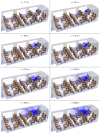3D modelling and simulation of the impact of wearing a mask on the dispersion of particles carrying the SARS-CoV-2 virus in a railway transport coach
- PMID: 37264020
- PMCID: PMC10234252
- DOI: 10.1038/s41598-023-35025-7
3D modelling and simulation of the impact of wearing a mask on the dispersion of particles carrying the SARS-CoV-2 virus in a railway transport coach
Abstract
Even though the Covid-19 pandemic seems to be stagnating or decreasing across the world, a resurgence of the disease or the occurrence of other epidemics caused by the aerial dissemination of pathogenic biological agents cannot be ruled out. These agents, in particular the virions of the Covid-19 disease, are found in the particles originating from the sputum of infected symptomatic or asymptomatic people. In previous research, we made use of a three-dimensional Computational Fluid Dynamics (CFD) model to simulate particle transport and dispersion in ventilated semi-confined spaces. By way of illustration, we considered a commuter train coach in which an infected passenger emitted droplets (1 and 10 µm) and drops (100 and 1000 µm) while breathing and coughing. Using an Eulerian approach and a Lagrangian approach, we modelled the dispersion of the particles in the turbulent flow generated by the ventilation of the coach. The simulations returned similar results from both approaches and clearly demonstrated the very distinct aerodynamics of the aerosol of airborne droplets and, at the other end of the spectrum, of drops falling or behaving like projectiles depending on their initial velocity. That numerical study considered passengers without protective masks. In this new phase of research, we first used literature data to develop a model of a typical surgical mask for use on a digital manikin representing a human. Next, we resumed the twin experiment of the railway coach, but this time, the passengers (including the infected one) were provided with surgical masks. We compared the spatial and temporal distributions of the particles depending on whether the spreader passenger wore a mask at all, and whether the mask was perfectly fitted (without leaks) or worn loosely (with leaks). Beyond demonstrating the obvious value of wearing a mask in limiting the dissemination of particles, our model and our simulations allow a quantification of the ratio of particles suspended in the coach depending on whether the infected passenger wears a mask or not. Moreover, the calculations carried out constitute only one illustrative application among many others, not only in public transport, but in any other public or private ventilated space on the basis of the same physical models and digital twins of the places considered. CFD therefore makes it possible to estimate the criticality of the occupation of places by people with or without a mask and to recommend measures in order to limit aerial contamination by any kind of airborne pathogen, such as the virions of Covid-19.
© 2023. The Author(s).
Conflict of interest statement
The authors declare no competing interests.
Figures



























References
-
- World Health Organization internet. https://www.who.int/fr/emergencies/diseases/novel-coronavirus-2019/quest... (2020).
-
- Bourouiba L. Turbulent gas clouds and respiratory pathogen emissions: Potential implications for reducing transmission of COVID-19. J. Am. Med. Assoc. 2020;323(18):1837–2183. - PubMed
-
- Wells WF. On airborne infection study II: Droplets and droplet nuclei. Am. J. Epidemiol. 1934;20(3):611–618. doi: 10.1093/oxfordjournals.aje.a118097. - DOI
MeSH terms
LinkOut - more resources
Full Text Sources
Medical
Miscellaneous

